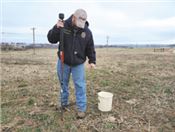Better Forage Through Soil Sampling

Taking soil samples with a sliding hammer.
U of A System Division of Agriculture photo by Dirk Philipp
FAYETTEVILLE, ARK.
Soil testing can help spot forage nutrient deficiencies that aren’t necessarily obvious to the eye, said Dirk Philipp, associate professor of animal science for the University of Arkansas System Division of Agriculture.
“There’s one thing landowners most likely overlook: taking soil samples on a regular basis,” he said. “Spotting nutrient deficiencies just by coloration or leaf patterns of the forage is difficult and takes experience.”
Fall and early winter are a good time to take soil samples, he said.
For Arkansas landowners, the Cooperative Extension Service provides free soil sample analysis. Results are typically available within a couple of weeks. (Learn more: https://www.uaex.edu/environment-nature/ soil/soil-test.aspx)
“The growth and health of forage plants not only depends on the abundance of the most common nutrients, such as nitrogen or potassium, but also to a large extent preventing certain minerals from dropping below a threshold,” Philipp said. “The only sure way of determining deficiencies is taking soil samples and running proper soil-chemical analyses to spot nutrient needs ahead of time.”
He said soil testing enables producers to spot a nutrient problem before it becomes very expensive to correct.
“Potassium fertilizer is expensive and replacing large amounts can easily cost several thousand dollars for a few acres,” Philipp said, adding that some crops are good at taking the nutrient out of the soil. “Potassium is removed in substantial amounts from hay crops and high-producing legumes such as alfalfa.”
Nutrient indicators
Not only do growers need to keep an eye on potassium, they also need to look at phosphorus and calcium levels, too.
“These are indicators for general levels of sufficiency of soil nutrients,” he said. “These three minerals are important for early plant development, so in newly planted forage stands these minerals are of importance.”
Philipp said producers also need to look out for soil pH over the long term. Soil testing gives an indication of acidity or alkalinity and “if it’s out of range – above 8 or below 5 – certain nutrients become less available and may even bind with compounds that become toxic.”
Plan ahead
When looking at soil health, Philipp said it’s important to plan ahead. “pH takes a long time to correct, usually several months.”
He also advises:
• Taking soil samples when preparing a new site, renovating a pasture or establishing new pastures from woody sites.
• Taking soil samples well ahead of time to correct deficiencies before planting.
• Following the recommendations of the soil test, including nitrogen – being sure not to “overshoot on nitrogen. Applying more than indicated doesn’t necessarily result in higher yields,” he said. ∆